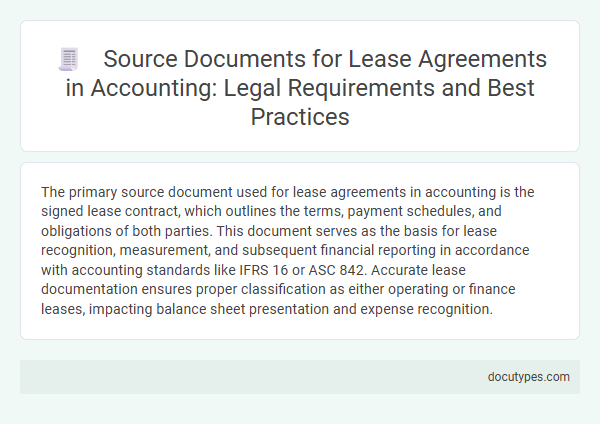The primary source document used for lease agreements in accounting is the signed lease contract, which outlines the terms, payment schedules, and obligations of both parties. This document serves as the basis for lease recognition, measurement, and subsequent financial reporting in accordance with accounting standards like IFRS 16 or ASC 842. Accurate lease documentation ensures proper classification as either operating or finance leases, impacting balance sheet presentation and expense recognition.
Introduction to Source Documents in Lease Accounting
Source documents play a crucial role in lease accounting by providing the original evidence required for recording lease transactions. Understanding which source document is used ensures accuracy and compliance in your financial reporting.
- Lease Agreement - The primary source document that outlines the terms, conditions, and obligations between the lessor and lessee.
- Invoice or Rent Receipt - Documents used to verify payment terms and amounts corresponding to the lease agreement.
- Amendments or Addendums - Additional documents that modify the original lease agreement and must be accounted for in the lease records.
Importance of Source Documents in Legal Compliance
Source documents serve as the foundational records for lease agreements in accounting, ensuring accuracy and legality in financial reporting. These documents are critical in maintaining compliance with legal standards and auditing requirements.
- Evidence of Agreement - Source documents provide verifiable proof of the terms and conditions agreed upon by both parties involved in the lease.
- Legal Compliance - Accurate source documents help organizations adhere to lease accounting standards such as IFRS 16 and ASC 842.
- Audit Trail - These documents create a clear audit trail that supports transparency and accountability in financial records.
Maintaining proper source documents is essential for legal validation and effective lease management in accounting.
Key Legal Requirements for Lease Agreement Documentation
| Key Legal Requirement | Details |
|---|---|
| Source Document Identification | Lease agreements serve as the primary source document in accounting for lease transactions, providing the legal framework and financial terms. |
| Parties Involved | Names and signatures of lessor and lessee must be clearly stated to establish legal enforceability. |
| Lease Term | Defined duration of the lease, including commencement and expiration dates, is essential for accurate accounting and compliance. |
| Lease Payments | Details on payment amounts, frequency, and methods must be documented to comply with accounting standards such as IFRS 16 or ASC 842. |
| Rights and Obligations | Explicit terms describing the lessee's right to use the asset and obligations regarding maintenance and liabilities ensure legal clarity. |
| Option Clauses | Renewal, purchase, or termination options should be included to reflect potential future accounting impacts. |
| Compliance with Local Laws | The document must align with jurisdiction-specific legislation governing lease agreements for enforceability and audit purposes. |
| Supporting Documentation | Attachments such as asset descriptions, insurance certificates, and approvals support the lease agreement's completeness. |
Types of Source Documents Used in Lease Agreements
Lease agreements in accounting rely on specific source documents to ensure accurate recording and compliance with financial standards. These documents provide essential details about the lease terms, payments, and obligations.
- Lease Contract - A formal agreement outlining the rights and responsibilities of the lessor and lessee, including lease term and payment schedule.
- Invoice or Rent Receipt - Records the actual payment transactions made by the lessee to the lessor throughout the lease period.
- Amendments or Addendums - Documents any changes or updates to the original lease agreement, such as modifications in lease duration or payment terms.
Essential Components of Lease Source Documents
Lease agreements in accounting rely on source documents that capture the contractual terms between the lessor and lessee. These documents serve as the foundation for accurate financial reporting and compliance with accounting standards.
Essential components of lease source documents include the lease term, payment schedules, and asset description. You must ensure these details are clearly outlined to facilitate proper lease classification and measurement in your accounting records.
Best Practices for Documenting Lease Transactions
The primary source document used for lease agreements in accounting is the signed lease contract between the lessor and lessee. This document outlines the lease terms, payment schedule, and obligations essential for accurate financial recording.
Best practices for documenting lease transactions include maintaining a clear, organized file with all related correspondence and amendments. You should ensure lease agreements are reviewed regularly to reflect any changes in terms or regulatory requirements.
Record Keeping Standards for Lease Documentation
The primary source document used for lease agreements in accounting is the signed lease contract. This document outlines the terms, payment schedule, and obligations of both parties involved in the lease.
Accurate record keeping requires maintaining a complete copy of the signed lease agreement to ensure compliance with accounting standards such as ASC 842 or IFRS 16. These standards mandate detailed documentation to verify lease classification, measurement, and recognition. Proper lease documentation supports audit trails and provides evidence for financial reporting and tax purposes.
Audit Trail and Verification of Lease Agreements
The primary source document used for lease agreements in accounting is the signed lease contract between the lessor and lessee. This document serves as a critical component of your audit trail, providing verifiable evidence of the terms and conditions agreed upon. Accurate lease contracts ensure proper verification and compliance during financial audits, minimizing the risk of discrepancies.
Common Challenges in Maintaining Lease Source Documents
The primary source document used for lease agreements in accounting is the signed lease contract, which outlines the terms, payment schedules, and obligations of both parties. Common challenges in maintaining lease source documents include ensuring accuracy, managing document versions, and safeguarding sensitive information. You must implement organized record-keeping systems to reduce risks of misplacement or data inconsistencies in lease accounting.
What Source Document Is Used for Lease Agreements in Accounting? Infographic

